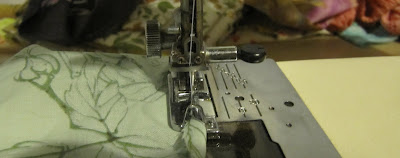Today, after visiting a
nearby strawbale home and interrogating the owners for a good hour or so, we all went up to the land to get us some more blackberries, this time with the intention of collecting enough berries to make some jam.
The main source of my experience with blackberries in the past has come about through my career as a bush regenerator. Many a sunny day was spent by me and my comrades crouched in the thorniness digging around trying to get out the pesky tap-root, and not, unfortunately partaking of the "juicy as" deliciousness. But those days are behind me now, not to say I haven't been deeply affected by them.
I'm loving the blackberries! Yes, I know they are a terrible pest and many many hours and dollars are spent by well-intentioned people each year trying to get rid of them. But you know what? They feed us. They feed us well. And they grow themselves. These sentiments are inclining me towards leaving the blackberries to ramble on our land, but the bush regenerator in me tells me I'm being irresponsible - a weak link in what should be a consolidated effort to get rid of them.
Weediness, I'm learning, is subjective. Just ask any permaculturist. And then ask a bush regenerator. There has been a long-standing perception of incompatability between these 2 (excellent) schools of thought which has, for the most part, seemed a little silly to me. But by jingo by crikey is it hotly debated, as was evinced at the
Weeds or Wild Nature? Forum I went to a few months back. Personally, I can pretty much wholeheartedly identify with and see the good in
both of these factions. Am I a fence-sitter? Not really. I prefer to see myself as a pragmatist who sees the good in both schools of thought and thinks they are not entirely mutually exclusive.
For example: I worked a site in Sydney that was a revegetated, regenerated corridor of 'bush' leading down to a large, constructed wetland and reserve that was built on an old dump site. No remnant bushland here, but we worked diligently, replanting and encouraging indigenous native plants and removing the 'weeds'. Except for the mulberry tree. It was huge and abundant and well-visited by many many locals. And its edible status seemed to give it a free pass, meaning that instead of cutting it down, as we would have done without question had it been, say, a liquid amber, we happily weeded 'weeds' out of the native grasses underneath and enjoyed the annual bounty. Weird eh?
But cool! NOT that I'm advocating planting edible exotics in tracts of remnant native bushland or orchards in the national park, but the mentality of either/or in an urban setting is, I think kinda crazy. Our urban and suburban spaces have been so irreversibly altered by the presence of white human settlement it seems slightly ill-conceived to try to pretend that revegetation of a piece of 'native bush' should exclude the edible plants we all rely on. And the same goes for rural land, like our precious 7 acres. Can't get much more altered than hundreds of trees cut down to make way for the planting of, what are according to bush regenerators, weeds, to grow the cows to make the milk so we can all eat
Bega cheese whenever we feel like it. So why not embrace the blackberries who thrive in the disturbed landscape? We embrace the cheese, after all.
But I also embrace the native grasses, shrubs, vines and trees. They, on par with the blackberries, warm my heart. I love that they have survived the last 150 years, that they're coming back, picking up where they left off when hundreds of cows started trampling them and chewing them and providing them with a tad more nitrogen than they'd probably like under 'normal' circumstances. I say bring on the coexistence. Except when it comes to introduced grass species. Several years of removing kikuyu and buffalo and ehrharta from native bushland is bound to give you more than a slight disdain for lawns. Not to mention the fact that they're total waste of resources. Lawns, you see, were invented a couple of hundred years ago by rich people who wanted to advertise the fact that they were so wealthy they didn't have to grow their own food. Nothing, not even 'weeds' invading 'native' bush, raises my hackles more than
conspicuous consumption, so I've basically got it in for lawns of any and all varieties. Oscar does too (well, he will once he's old enough to be brainwashed) but he's also pretty keen on the hand mover I picked up at the tip shop for 5 bucks so I could 'maintain' the lawn at our rental place.

And now, for your reading pleasure and to reiterate the sentiments contained within this rant, I give you God's thoughts on lawn, courtesy of Paul Wheaton's awesomely awesome and inspiring permaculture blog. God on Lawns
Imagine the conversation The Creator might have had with St. Francis on the subject of lawns:God: Hey St. Francis, you know all about gardens and nature. What in the world is going on down there in the Midwest? What happened to the dandelions, violets, thistle and stuff I started eons ago? I had a perfect "no maintenance" garden plan. Those plants grow in any type of soil, withstand drought and multiply with abandon. The nectar from the long lasting blossoms attracts butterflies, honey bees and flocks of songbirds. I expected to see a vast garden of colors by now. But all I see are these green rectangles.
St. Francis: It's the tribes that settled there, Lord. The Suburbanites. They started calling your flowers "weeds" and went to great lengths to kill them and replace them with grass.
God: Grass? But it's so boring. It's not colorful. It doesn't attract butterflies, birds and bees, only grubs and sod worms. It's temperamental with temperatures. Do these Suburbanites really want all that grass growing there?
St. Francis: Apparently so, Lord. They go to great pains to grow it and keep it green. The begin each spring by fertilizing grass and poisoning any other plant that crops up in the lawn.
God: The spring rains and warm weather probably make grass grow really fast. That must make the Suburbanites happy.
St. Francis: Apparently not, Lord. As soon as it grows a little, they cut it... sometimes twice a week.
God: They cut it? Do they then bail it like hay?
St. Francis: Not exactly, Lord. Most of them rake it up and put it in bags.
God: They bag it? Why? Is it a cash crop? Do they sell it?
St. Francis: No Sir. Just the opposite. They pay to throw it away.
God: Now let me get this straight. They fertilize grass so when it does grow, they cut it off and pay to throw it away?
St. Francis: Yes, Sir.
God: These Suburbanites must be relieved in the summer when we cut back on the rain and turn up the heat. That surely slows the growth and saves them a lot of work.
St. Francis: You are not going to believe this Lord. When the grass stops growing so fast, they drag out hoses and pay more money to water it so they can continue to mow it and pay to get rid of it.
God: What nonsense. At least they kept some of the trees. That was a sheer stroke of genius, if I do say so myself. The trees grow leaves in the spring to provide beauty and shade in the summer. In the autumn they fall to the ground and form a natural blanket to keep moisture in the soil and protect the trees and bushes. Plus, as they rot, the leaves form compost to enhance the soil. It's a natural circle of life.
St. Francis: You better sit down, Lord. The Suburbanites have drawn a new circle. As soon as the leaves fall, they rake them into great piles and pay to have them hauled away.
God: No. What do they do to protect the shrub and tree roots in the winter and to keep the soil moist and loose?
St. Francis: After throwing away the leaves, they go out and buy something which they call mulch. The haul it home and spread it around in place of the leaves.
God: And where do they get this mulch?
St. Francis: They cut down trees and grind them up to make the mulch.
God: Enough. I don't want to think about this anymore. Sister Catherine, you're in charge of the arts. What movie have you scheduled for us tonight?
Sister Catherine: "Dumb and Dumber", Lord. It's a real stupid movie about.....
God: Never mind, I think I just heard the whole story from St. Francis.






























 And this one is a grey and green striped wool which is kind of like a very fine sweater-weight. The collar on this is a gorgeous vintage print.
And this one is a grey and green striped wool which is kind of like a very fine sweater-weight. The collar on this is a gorgeous vintage print.